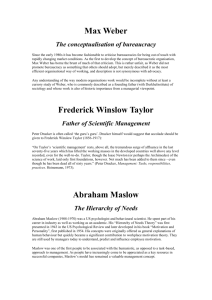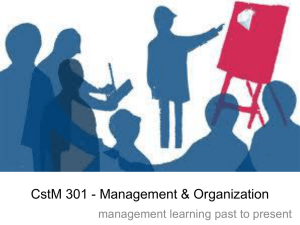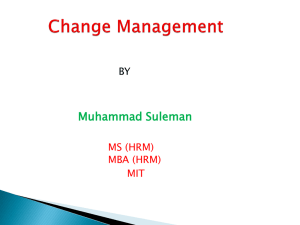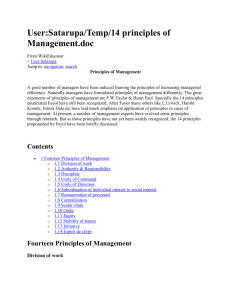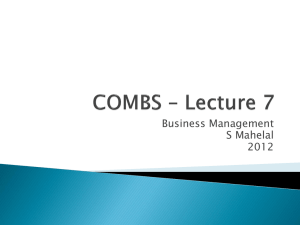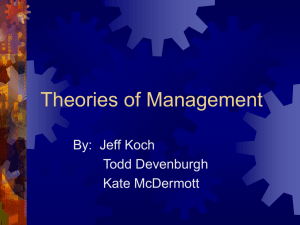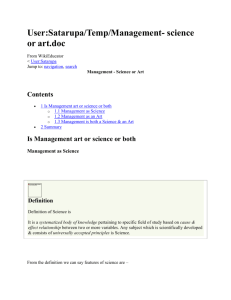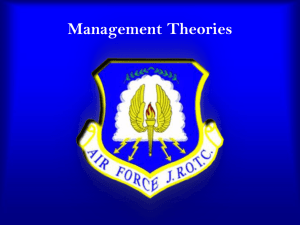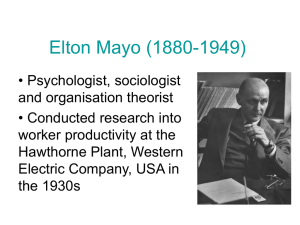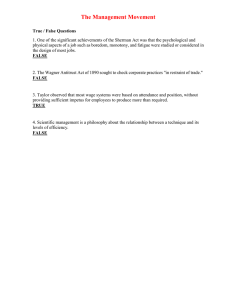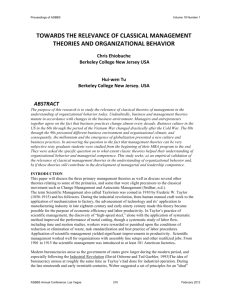User:Satarupa/Temp/Theories of Management
advertisement
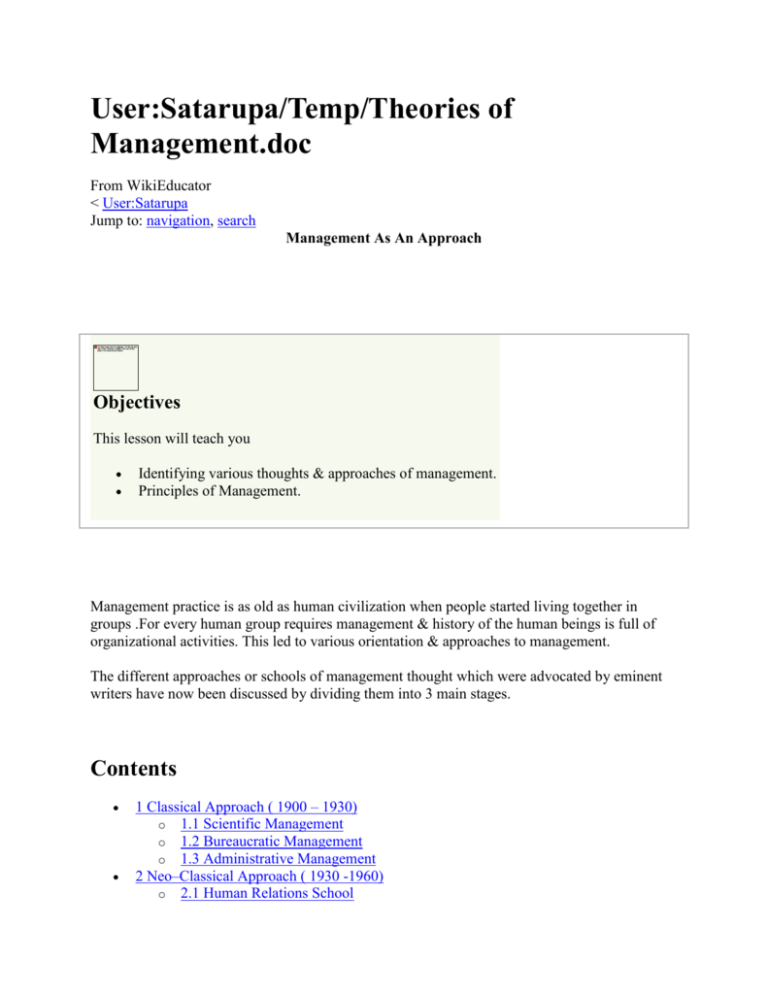
User:Satarupa/Temp/Theories of Management.doc From WikiEducator < User:Satarupa Jump to: navigation, search Management As An Approach Objectives This lesson will teach you Identifying various thoughts & approaches of management. Principles of Management. Management practice is as old as human civilization when people started living together in groups .For every human group requires management & history of the human beings is full of organizational activities. This led to various orientation & approaches to management. The different approaches or schools of management thought which were advocated by eminent writers have now been discussed by dividing them into 3 main stages. Contents 1 Classical Approach ( 1900 – 1930) o 1.1 Scientific Management o 1.2 Bureaucratic Management o 1.3 Administrative Management 2 Neo–Classical Approach ( 1930 -1960) o 2.1 Human Relations School o 2.2 Human Behavioral School 3 Modern Approach ( 1960 – till now) o 3.1 Management Science o 3.2 Operational Approach o 3.3 Decision Theory Approach o 3.4 Systems Approach Classical Approach ( 1900 – 1930) Basic Principles The Approach is closely related with the industrial revolution & the growth of large scale undertaking which demands the new form of organization & management practices. It focuses on job content, structure, division of labour, functions of management, standardization, simplifications & specialization. Traditional/ Classical Approach stands on 3 pillars – Scientific Management Scientific Management says that the principles & methods are to be determined through observations & experiments. This thought is propounded by F.W.Taylor. Other contributors were H.L.Gantt, Frank & Lilian Gilberth etc. Taylor in his words expressed Scientific Management as “ Scientific Management is knowing exactly what you want men to do & seeing that they do it in the best & cheapest way.” Contribution by Taylor According to Taylor, main theme of Scientific Management is to enrich the workers & management by bringing revolutionary change in ideas, thoughts & activities of them. The fundamental principles are as follows – Science not the rule of thumb - According to this, work assigned to the employee should be observed & analyzed in respect to time & part involved. Harmony not discard/ Cooperation between employers & employees. Scientific selection, training & development Division of work/ responsibility Benefits of Scientific Management Increase in production Creation of inspiration towards work Possibility of removing wastage in time Increase in quality & reduction in cost of production Cordial relationship between workers & employees. After Taylor, experiments on Scientific Management were continued by his followers. Among them notable are H.L Gantt, F.B. Gilberth. Contribution by H.L. Gantt Gantt had laid down 4 remarkable contributions Use of graph for comparing the actual performance with pre-determined one Introduction of task & bonus plan as the method of remuneration to employees. Social responsibility in business (which indicates obligation to the welfare of society where it is operating) through proper employee training. More emphasis on work than on earning profit. Contribution by Gilberth Frank Gilberth & his wife Lilian Gilberth were contemporary of Taylor. They worked independently on Time & Motion study. F. Gilberth is called father of Motion study whereas L. Gilberth considerably contributed to psychology & management. Both of them laid foundation on modern application of incentive wage system, simplification of tasks & standard of meaningful activities. Top of Page Bureaucratic Management Contribution by Max Weber As a German academic, Weber was primarily interested in the reasons behind the employees’ actions and in why people who work in an organization accept the authority of their superiors and comply with the rules of the organization. Legitimate Types of Authority by Max Weber Traditional authority – Traditional authority is readily accepted and unquestioned by individuals since it emanates from deeply set customs and tradition. Traditional authority is found in tribes and monarchies. Charismatic authority – Charismatic authority is gained by those individuals who have gained the respect and trust of their followers. This type of authority is exercised by a charismatic leader in small and large groups alike. Rational-legal authority – Rational-legal authority stems from the setup of an organization and the position held by the person in authority. Rational-legal authority is exercised within the stipulated rules and procedures of an organization. Weber coined this last type of authority with the name of a bureaucracy. The term bureaucracy in terms of an organization refers to the following six characteristics: Management by rules. A bureaucracy follows a consistent set of rules that control the functions of the organization. Division of labor. Authority and responsibility are clearly defined and officially sanctioned. Jobs descriptions are specified with responsibilities and line of authority. Formal hierarchical structure. An organization is organized into a hierarchy of authority and follows a clear chain of command. Personnel hired on grounds of technical competence. Appointment to a position within the organization is made on the grounds of technical competence. Managers are salaried officials. A manager is a salaried official and does own the administered unit. Written documents. All decisions, rules and actions taken by the organization are formulated and recorded in writing. Top of Page Administrative Management Contribution by Henry Fayol A good number of managers have been induced framing the principles of increasing managerial efficiency. Naturally managers have formulated principles of management differently. The great exponents of principles of management are F.W.Taylor & Henri Fayol. Specially the 14 principles enunciated Fayol have still been recognized. Division of work Division of work means to divide the work among the workers according to their capacity & quality on scientific basis The purpose of division of work is to derive the benefits from the principles of specialization. Division of work produces more & better work with the same effort. Authority & Responsibility Authority is the right to give orders & power to exact obedience & responsibility is corollary/outcome to authority. Authority is a combination of official & personal factors. Authority is the formal & legitimate right of the manager to make decisions, issue orders & allocate resources to achieve organizational goals. Responsibility on the other hand is the obligation to which a person is bound by reason of his status. Discipline Discipline is the obedience, application, energy, behavior & outward marks observed in accordance with standing agreements between employer & employee. The best means of establishing & maintaining discipline are good supervisors at all levels, agreement as clear & fair as possible& penalties judiciously applied. It is absolutely essential for smooth running of business. Unity of Command This principle means that an employee should receive orders from one superior only. If two superiors exercise their authority over the same person or department, it may cause uneasiness or disaster. Unity of Direction It means one head & one plan for group of activities having the same objective. It is essential for unity of action, co- ordination of strength & focusing of effort. The unity of direction is different from unity of command in the sense that the former is concerned with the functioning of body corporate while the later is with functioning of personnel. Subordination of individual interest to social interest The meaning of this principle is individual interest or group interest should not over power the interest of the organization. Remuneration of personnel Remuneration of personnel is the price of service rendered by them. It should be fair & maximum possible satisfaction to employees & employers. Centralization Everything which goes to increase the importance of subordinate’s role is centralization, everything which goes to reduce it is decentralization. The degree of centralization must vary according to different cases. This is determined by individual circumstances & should be based on individual circumstances & should be based on optimum utilization of all faculties of the personnel. In small organization there is absolute centralization, but in large concerns, there are series of intermediaries between top & bottom levels. Scalar chain It is the chain of superiors ranging from the ultimate authority to the lower level. It implies that line of authority should be followed which comes from or lead to ultimate authority. Order This is a principle relating to arrangement of things & people. In case of things the formula is “ a place for everything & everything in its place.” It is the same case for human order – “a place for everyone & everyone in his place” i.e. the right man in right job. Equity Equity is the combination of justice & kindliness to the employees at all levels. The application requires good sense, experience, good nature & devotion from subordinates. Stability of tenure Time is quite essential for an employee to get accustomed to a new work & succeed it in doing well. If an employee is removed when he has got not accustomed to it, he will not get enough time to render worthwhile service. Initiative Is concerned with thinking out & execution of a plan. At all levels of organizational hierarchy, zeal & energy of employees are augmented by initiative. Managers should secure as much initiative as possible from the subordinates. Espirit de corps This is the principle of Union is strength. Business leaders must remember this principle. Harmony of personnel of an undertaking is a source of great strength. Contribution by Chester Barnard Chester Barnard contributed two theories to management which are very helpful even today. These are: Theory of Authority & Theory of Incentives. Both are based on communication system that should be based on some essential rules: Everyone should know the channels of communication Everyone should have access to the formal channels of communication. Lines of communication should be as short & as direct as possible Activity Do Comparative Study between contributions of Taylor & Fayol. Top of Page Neo–Classical Approach ( 1930 -1960) Basic Principles Business organization is not techno economic, rather a social system. Economic incentives can’t be the only motivator but there has to be many social & psychological wants. Democratic leadership, not authoritarian, is considered to be the most essential for satisfying the psychological demands. In order to establish a clear understanding, an effective two way communication is essential. Since morale & productivity is directly related, the management must take greater interest in employee development & worker’s satisfaction. Human Relations School Contribution by Elton Mayo Hawthorne study Elton Mayo conducted series of experiments at Western Electric Hawthorne Works, Chicago & interviewed employees over there. His observational studies included Illumination experiments: To find out effect of illumination on worker’s productivity. Relay Assembly Test Room Experiments: To find out effect of changes in working conditions & hours. Mass interviewing programme: To find out worker’s attitudes & sentiments Bank wiring observation room experiments: To find out social aspects of work organization. Result of the experiment To his amazement Elton Mayo discovered a general upward trend in production, completely independent of any of the changes he made. Regular medical checks showed no signs of cumulative fatigue & absence from work declined by 80%. Implications Elton Mayo opened a new chapter in management by suggesting management through good human relations. Social factor in output: An organization is not merely a formal structure where production is determined by official prescription. It is a structure in which production norms are set by social norms. Group influence: Management can’t deal with workers as individuals but as members of groups. Leadership: Leadership is important for directing group behaviour. Incentives: Financial incentives is far less powerful than personal or social incentives. Communication: Communication is the organization is highly recommended. Human Behavioral School Hawthorne experiments opened new window to the study of management. The theory of motivation comes to light to provide inspiration to workers. Contribution by Maslow Maslow’s contribution to management is the hierarchy of human needs. Self Actualization Needs [Desire to become what one is capable of becoming, to maximize one’s potential & to accomplish something] ⇑ Esteem Needs [After human satisfy social needs they need to be held in esteem- both by self esteem & Esteem from others] ⇑ Social Needs [Need to be belonged, to be accepted, need for friendship, love, respect] ⇑ Safety Needs [Needs to be free of physical danger & of fear of losing job, property, food etc] ⇑ Physiological Needs [Basic needs for sustaining human life such as food, water, shelter, sleep] Contribution by Mc Gregor Mc Gregor called his theories THEORY X & THEORY Y Assumptions THEORY X Human inherently dislike working & will try to avoid it Since people dislike work they need to be forced, controlled & managed Average employees want to be directed People don’t like responsibility Applications Conducive to Management style Average humans are clear & unambiguous & want to feel secure at work. Shop floor, Mass manufacturing, Production workers Large scale efficient operations Hard management THEORY Y People view work as natural as play & rest. People are self motivated Job satisfaction is the key to engaging employees towards their commitment People learn to accept responsibility, seek it also. People are imaginative & creative. Professional service, managers & professionals Management of professionals Soft management Contribution by Herzberg Herzberg proposed the two factor theory of human motivation at the work place. Hygiene Needs These needs don’t motivate in the sense of yielding satisfaction, but their lack of existence , however results in dissatisfaction Policy Relationship with supervisor Work Condition Salary Facilities by company Motivation Needs These needs lead to motivation & psychological growth Challenge Autonomy Intrinsic interests Creative opportunities Personal growth Top of Page Modern Approach ( 1960 – till now) Management Science Basic Principles Management is regarded as Problem solving mechanism with help of mathematical tools. Management activities can be quantified. Covers decision making, system analysis & some aspects of human behaviour. This approach draws many things from decision theory approach & provides many techniques for rational decision making. Operational Approach Basic Principles Emphasis on management functions & principles involved in performing Management functions are universal. Conceptual framework of management can be constructed on the basis of analysis of management process Central core of managing revolves round planning, organizing, staffing, directing & controlling. Decision Theory Approach Basic Principles Management is essentially decision making. Members of organization are decision makers & problem solvers Organization can be treated as combination of various decision centres. Quality of decision affects the organizational effectiveness. All factors affecting decision making are area of study for managers. Other factors affecting decisions are process, information system, social & psychological aspects of decision makers Systems Approach Basic Principles It is an integrating approach, which considers management in its totality, is based on empirical data. Basic idea of this approach is any object must rely on empirical data as well as on method of analysis involving simultaneous variations of mutually dependent variables. The major components of the system are : 1. Inputs: The various human, material, financial, equipment & informational resources required to produce goods and services. 2. Transformation Process: The organization’s managerial & technological abilities that are applied to convert inputs into outputs. 3. Outputs: The products, services & other outcomes produced by the organization. 4. Feedback: Information about results & organizational status relative to its environment. Top of Page Classifications of Systems Closed Vs. Open Closed systems are those systems, which have no interaction with the internal & external environment. These are self contained & self-maintaining. These are generally mechanical. Open system are those which interact with environment. They import energy & export output. This is characterized by negative entropy ( i.e. bringing new energy in forms of inputs & feedback from the environment in order to delay or arrest entropy, the decaying process). Open system have feedback mechanism. Top of Page | Work in progress, expect frequent changes. Help and feedback is welcome. See discussion page. Retrieved from "http://wikieducator.org/index.php?title=User:Satarupa/Temp/Theories_of_Management.doc&ol did=610469" Category: Work in progress Navigation menu Personal tools Log in Request account Namespaces User page Discussion Variants Views Read View source View history Actions Search Search Go Navigation Main Page Recent changes Help Practice editing Community Community portal Web chat Mailing list Print/export Create a book Download as PDF Printable version Tools What links here Related changes User contributions Logs Upload file Special pages Permanent link Page information This page was last modified on 17 September 2010, at 10:53. This page has been accessed 1,931 times. Content is available under the Creative Commons Attribution Share Alike License unless otherwise noted. Privacy policy About WikiEducator Disclaimers
